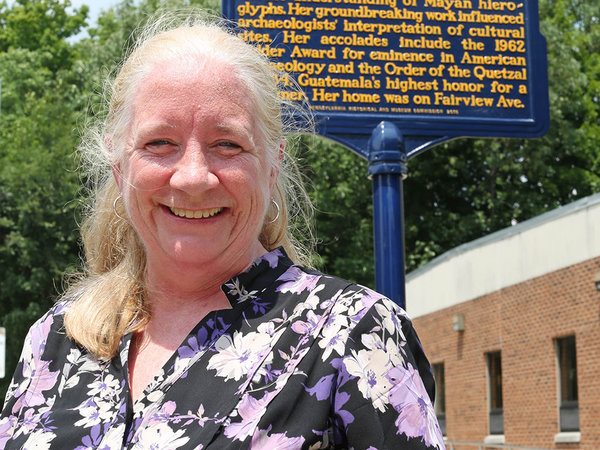By Michael Vitez
The Philadelphia Inquirer.
On Lansdowne Avenue, next to two benches and a bus stop, stands a new historical marker, blue with gold letters, 10 feet tall.
“Looks nice,” said Robyn Young, 61, the woman responsible, seeing it for the first time this week. “Taller than I thought it would be.”
She pushed on the pole, kicked at the fresh dirt.
“It’s in there nice and firm.”
Dedicated to archaeologist Tatiana Proskouriakoff, who “published a paper that revolutionized the world’s understanding of Mayan hieroglyphs,” the marker culminates years of effort by Young.
The Media woman has dedicated herself for the last 15 years to fixing a gender equity issue of historic proportions.
“I think women need to be represented in history,” she says. “And they’re not.”
Of approximately 2,000 historical markers in Pennsylvania, only 200 are devoted to the deeds of women. Fourteen are there because of Young’s efforts.
“Perhaps most impressive is her unique ability to identify key people in the commonwealth’s history that might otherwise be little remembered in the future, despite great accomplishments,” said Bill Lewis, a member of the Pennsylvania Historical Museum Commission, and chair of its Historic Marker Selection Committee.
Young traces her passion to the treatment of Anita Hill during the Clarence Thomas Supreme Court confirmation hearings. She joined the National Organization for Women, becoming chair of the Chester County chapter for nine years.
Traveling to Seneca Falls, N.Y., site of the first women’s rights convention, “changed my life,” she says.
“I had never seen women revered like that in Pennsylvania.”
Inspired to create watercolor paintings of the homes of important women from the region, she was shocked to find no historical markers outside many of the homes.
This started her crusade, and in 2001, she got three marker nominations approved — for the site of the 1852 women’s rights convention in West Chester; for Ann Preston of West Grove, one of the state’s first women doctors and America’s first female dean of a medical school; and for folk artist Ida Ella Ruth Jones of Chester County, daughter of a former slave.
For years, rising at 4 a.m and doing research before her day job as a paralegal, and again in the evenings, Young researched these women and prepared her nominations.
In 2008, she took a historic walking tour of Lansdowne, and heard about Tatiana Proskouriakoff.
She found a biography, and the biographer will be among those at the marker’s dedication, at noon Saturday, on the corner of Lansdowne and Fairview Avenues in Lansdowne.
Proskouriakoff, born in Siberia, came to America with her parents, a chemist and a doctor, and was raised in Lansdowne. She worked at the Penn Museum, where the centerpiece of its Mexico and Central America gallery is the famous Stela 14 from Piedras Negras, the stone monument that Proskouriakoff used to “crack the code” of ancient Maya hieroglyphics.
In a 50-year career, she became one of the world’s premier Mayan scholars.
“I was so impressed by Robyn’s dedication to bringing to light important women in Pennsylvania history,” said Suzanna Barucco, who attended last month’s dedication in Chester of a marker for Ethel Waters, the famous blues and jazz singer, also nominated by Young.
“The engine that drives the historic marker program is people like Robyn who take it upon themselves to write an application, engage a community for support, and raise the funds to erect a marker,” said Barucco, who chairs the state historic preservation board.
For many years, Young spent as much or more time fund-raising as she did researching. If approved, each marker costs over $2,300, she said, and nominators must pay for its creation and installation.
Last year, she wrote to H.F. “Gerry” Lenfest, the philanthropist who owns Philadelphia Media Network, parent company of The Inquirer. He is the newspaper’s publisher.
“I just send him the bills, and he sends the checks out,” she said.
Three more markers will be placed this fall:
Mildred Scott Olmsted of Rose Valley, a pioneer in the peace, suffrage, and Planned Parenthood movements, who for 20 years led the Women’s International League for Peace and Freedom.
Sarah Josepha Hale of Philadelphia, author of the nursery rhyme “Mary Had a Little Lamb.” For 17 years, Hale pushed for a national Thanksgiving Day holiday which President Abraham Lincoln finally supported in 1863.
Mary Ann Shadd Cary of West Chester, an abolitionist who became the first female African American newspaper editor in North America when she edited the Provincial Freeman in 1853.














































































































































































































































































































































































